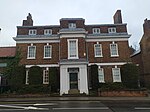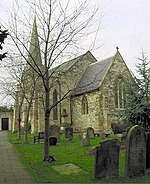Woodthorpe, North Yorkshire

Woodthorpe is a suburb in the south west of the city of York, in the ceremonial county of North Yorkshire, England. The surrounding areas are Dringhouses and Foxwood. The area of Woodthorpe was built in several phases from the 1960s to the 1990s. The name Woodthorpe is believed to have been the name of one of the first large housing development projects around the Moorcroft Road and Acorn Way area and this name has stuck. Locally the name Woodthorpe is generally used for the areas south of Acomb Wood and east to Moorcroft Road and Acorn Way. To the east is Dringhouses, to the north is Foxwood, and to the west is Acomb Park. In January 2017 the suburb made national headlines when seven year old Katie Rough was killed by asphyxiation and stabbed in the neck near her home by a 15-year-old female.
Excerpt from the Wikipedia article Woodthorpe, North Yorkshire (License: CC BY-SA 3.0, Authors, Images).Woodthorpe, North Yorkshire
Summerfield Road, York Woodthorpe
Geographical coordinates (GPS) Address Nearby Places Show on map
Geographical coordinates (GPS)
| Latitude | Longitude |
|---|---|
| N 53.93743 ° | E -1.12737 ° |
Address
Summerfield Road 12
YO24 2SD York, Woodthorpe
England, United Kingdom
Open on Google Maps









